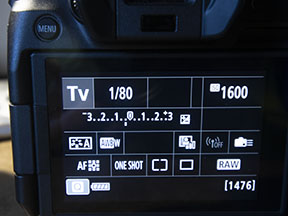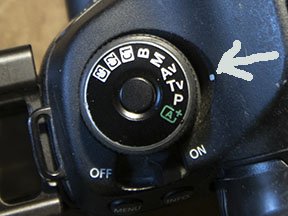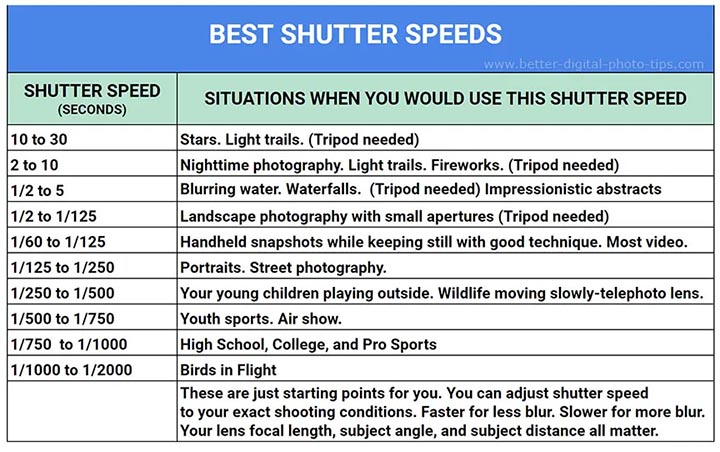Canon Shutter Mode
This post will cover the Canon shutter mode settings you need to know about. You're going to see how you can control the shutter speed for the exact effect you want as well as select silent shutter mode to shoot a photo quietly in perfect silence.
Selecting the right shutter speed will stop or enhance motion blur in your photos. Selecting a silent shutter will let you take a photograph without being noticed.
JUMP TO SECTION:
We'll look at why you'd want to use a silent shutter in a minute, but first let's take a look at when you'd want to use shutter mode with your Canon camera.
What Mode Controls Shutter Speed
Shutter Priority is the name of the mode for the camera setting to use when you want to set the exact shutter speed. Shutter priority mode is an automatic mode where you set the shutter speed and your Canon camera will set the aperture (f/stop) number correctly to give you a proper exposure.
With Canon cameras the shutter priority symbol appears as Tv. Think of it translating as Time Value. See shutter priority mode indicators below.



Depending on your specific Canon, you can view and change to shutter mode on the LCD screen located on the back of your camera, on the small screen on top of your camera, on a settings dial on top of your camera, or within the viewfinder.
When To Use Shutter Mode
There are many situations in photography where using a camera setting where you decide the exact shutter speed is important. Set your camera to a slow shutter when you want a specific amount of blur in your subject for a creative effect
The slow shutter speed photo below was a lucky mistake, but a perfect example of a fascinating effect you can get by using a shutter priority settings on your camera. Typically, you'd think you always want to use a fast shutter speed when photographing birds in flight. That's often correct.
With some of the geese stationary, and some of the geese in flight, the situation was ripe for using a moderately slow shutter speed to get some motionless and some motion-blurred wildlife in the same photograph.
Where To Change Shutter Mode on Canon Camera
There are many different Canon digital camera models with different builds and layouts. You can change the shutter mode in the camera's menu using the LCD screen on the back of your camera or my adjusting a dial on top of the camera.
Use your printed camera manual or visit Canon USA's library of digital camera manuals.
What Is Silent Mode On Canon Cameras
You may be wondering if you can turn off the shutter sound on a Canon camera.
Your Canon camera may have a technology called silent shooting. Silent mode is a camera feature that enables you take photos without any noise from engaging the shutter. In true silent mode, instead of a physical mechanical shutter, cameras use an electronic shutter by quickly turning the sensor on and off to begin and end the exposure.
Photos are effected differently, depending on the camera settings and which Canon camera your shooting with. Silent mode on the modern
Canon DSLR cameras gives you shutter sound with less noise, but it's not completely silent. Silent mode on Canon mirrorless cameras is truly silent:
Differences Between Mechanical and Electronic Shutters
Mechanical shutters use physicals curtains in front of the camera's sensor that move out of the way to expose the sensor to light. Mechanical shutter are better in some ways for capturing high speed sports and other action photography. The action is captured for everything within the viewfinder at exactly the same time to "freeze" the motion.
Electronic shutters have no moving parts. You can give you a faster burst rate (in frames per second) and faster shutter speeds. For example, the Canon mirrorless R3 camera can give you an incredible minimum 1/64000 second shutter when using the electronic shutter versus 1/8000 second exposure with a mechanical shutter.
Why Use Silent Shutter Mode
It's good to know the reasons on why you'd want to employ a silent shutter and when a mechanical shutter makes more sense to use. First we'll look at the advantages and disadvantages of using the electronic shutter and then we'll look at the specific shooting situations on when to use the electronic shutter mode.
Advantages Of Electronic Shutter
SILENCE. The biggest advantage of using the electronic shutter mode is the absence of noise from the shutter when you take a photo.
BURST RATE. Electronic shutters usually give you faster continuous shooting, also referred to as burst rate and abbreviated as fps (frames-per-second).
SHUTTER SPEED. Just as mentioned previously (with the EOS R3 camera), you can achieve faster shutters speeds with an electronic shutter setting rather than a mechanical shutter setting.
Disadvantages Of Electronic Shutter
ROLLING SHUTTER. The biggest issue with choosing to engage the silent electronic shutter is called "rolling shutter." The light information that is read from the camera sensor pixels is gathered row by row. Super fast moving subjects move during the time it takes for all of the light information. See the rotor blades in the photo below.
 Example of rolling shutter distortion from super fast shutter
Example of rolling shutter distortion from super fast shutterPhoto by Jonen on Wikipedia
BANDING. Another issue that can arise with artificial light sources like fluorescent and LED lit scenes is banding. These lights flicker at a super fast rate and the brightness and color temperature of the lights can change as the information is being read from the sensor.
 Photo of my television screen @ 1/800 second
Photo of my television screen @ 1/800 secondExample of banding with flickering artificial light source.
The easiest way to see banding for yourself is to take a few photos of your television set using faster shutter speeds.
EXPERIENCE. There is that moment of satisfaction geeky photographers like me experience when we push the shutter button and here that sound that confirms we've successfully captured the scene in front of us. When the sound of a mechanical shutter is absent, you may not get that little hit of dopamine from the act of making a photograph.
When To Use Silent Shutter Mode
EVENTS. Wedding photographers love shooting in silent mode. Some pastors or priests even require it nowadays. With any event that is going on in a super quiet environment, the annoying click from cameras should not be heard.
WILDLIFE. Birds and other wildlife are often startled by unusual noises. You don't want to scare off your subject with the sound of your camera shutter.
STREET PHOTOGRAPHY. The best street photography is accomplished when the photographer is neither seen nor heard.
LONG EXPOSURE. Eliminating the possibility of camera shake is vital to sharp photos when using long exposures. Changing from a mechanical shutter with moving curtains to an electronic shutter with no moving parts, combined with using a sturdy tripod is a smart move. Here's the complete article on Canon Long Exposure Photography.
Shutter Mode Summary
Now that you have a basic understanding of shutter modes and shutter settings for your Canon camera you'll be able to take advantage of the technology that is available to you to take great photos. Being able to both control the shutter speed setting and the silent shutter mode for certain situations gives you a great advantage. For more information on other settings see my Complete Guide on all Canon Camera Settings.
I hope this article helps you stay inspired to enjoy your photography at a whole new level.
Have a blast. Shoot a Canon!


Bruce Lovelace is the publisher of Canon Camera Geek. Read more about him on the About Page. He also publishes how to articles and camera gear reviews at the Photography Tips website.
View some of Bruce's photos on Instagram and Flickr. Join the tribe of followers on YouTube. Bruce also runs photo workshops and provides 1 on 1 digital photography coaching.
Recent Articles
-
My Review of The 10 Best Canon R6 Mark II Features That Impressed Me
Apr 12, 25 08:51 AM
Beyond the Pixel: Discover the Game-Changing Features That Make the Canon R6 Mark II a Must Have Camera -
Canon RF 24-105 Lens Comparison. Guide To Which One Is Right For You
Apr 07, 25 12:47 PM
Which is the best of the 3 versions of the Canon RF 24-105mm Lens for Canon mirrorless cameras? What's The 24-105 Lens Good For -
3 Better Alternatives to Camera Bags From Canon. Helpful Guide To Bags
Apr 03, 25 11:51 AM
After searching for the top best selling Canon bags, I found 3 better alternatives to camera bags from Canon -
Canon 70-200 2.8 Tripod Collar. Article and Video of The Advantages
Apr 03, 25 11:02 AM
Some call it an optional accessory. I say a canon 70-200 2.8 tripod collar is a necessity when using this lens on a tripod or monopod. -
Running With The G1X Mark II, Acting Like a Kid, You Should Try This
Apr 03, 25 10:31 AM
Ever get a new "toy" and want to just play? I did.Got my new Canon compact camera. Went running with the G1x Mark II












